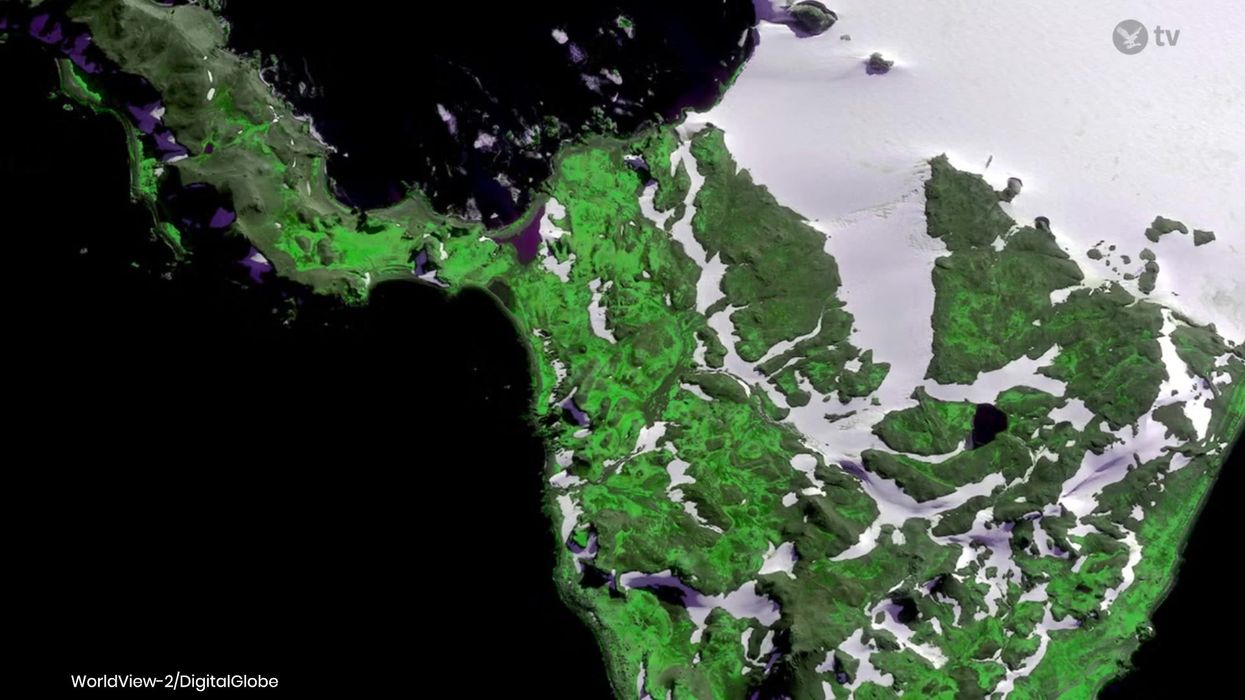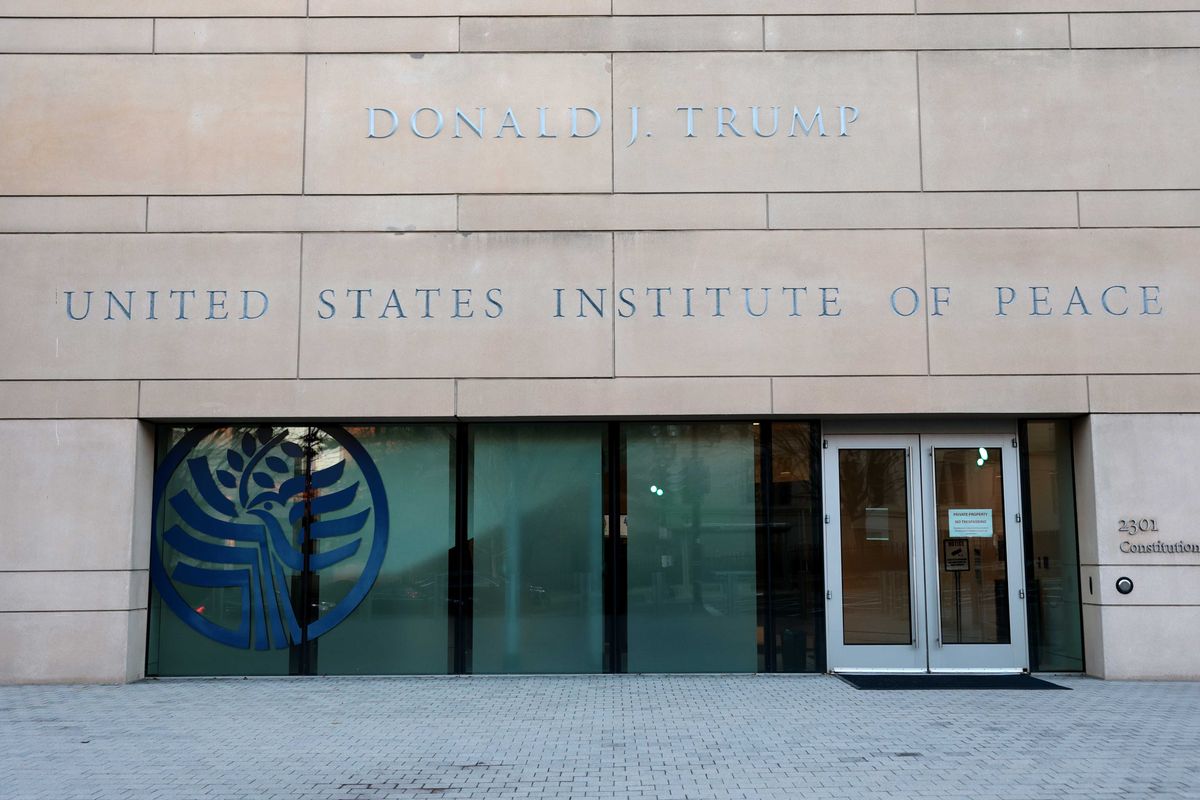Sinead Butler
Oct 08, 2024
Satellite images show Antarctica is turning ‘green’ faster than previously thought
Various
When we think of Antarctica, an icy landscape typically comes to mind, however, new research has found the continent is "greening" at a worrying rate.
Within almost four decades, the Antarctic Peninsula has seen the amount of greenery increase by over 1,000 per cent - with mosses being the type of greenery found growing on the land.
This is a stark contrast compared to 38 years ago when there was less than one square kilometre of vegetation on the peninsula, and by 2021 greenery expanded to 12 sq kilometres, according to satellite data analysed as part of the study.
Within five years (2016-2021), there was a 30 per cent acceleration in plant cover during a time in which Earth experienced record-high temperatures, a factor which researchers say has played a role in the "greening" trend, along with a decline in Arctic sea ice.
The research into the Antarctic Peninsula's changing landscape was conducted by scientists at the University of Exeter, the University of Herefordshire and the British Antarctic Survey and published in the Nature Geoscience journal.
[rebelmouse-image 53781186 expand=1 dam=1 alt="" site_id=24473854 is_animated_gif=false original_size="2122x1412" crop_info="%7B%22image%22%3A%20%22https%3A//assets.rbl.ms/53781186/origin.jpg%22%2C%20%22thumbnails%22%3A%20%7B%22origin%22%3A%20%22https%3A//assets.rbl.ms/53781186/origin.jpg%22%2C%20%22600x200%22%3A%20%22https%3A//www.indy100.com/media-library/eyJhbGciOiJIUzI1NiIsInR5cCI6IkpXVCJ9.eyJpbWFnZSI6Imh0dHBzOi8vYXNzZXRzLnJibC5tcy81Mzc4MTE4Ni9vcmlnaW4uanBnIiwiZXhwaXJlc19hdCI6MTc2ODgxNDIzM30.n541BHwZmhxtnm2QV2sYWcByOhgRDtzFsR92rs5iZh0/image.jpg%3Fwidth%3D600%26height%3D200%26coordinates%3D0%252C352%252C0%252C353%22%2C%20%22750x1000%22%3A%20%22https%3A//www.indy100.com/media-library/eyJhbGciOiJIUzI1NiIsInR5cCI6IkpXVCJ9.eyJpbWFnZSI6Imh0dHBzOi8vYXNzZXRzLnJibC5tcy81Mzc4MTE4Ni9vcmlnaW4uanBnIiwiZXhwaXJlc19hdCI6MTc2ODgxNDIzM30.n541BHwZmhxtnm2QV2sYWcByOhgRDtzFsR92rs5iZh0/image.jpg%3Fwidth%3D750%26height%3D1000%26coordinates%3D531%252C0%252C532%252C0%22%2C%20%22700x1245%22%3A%20%22https%3A//www.indy100.com/media-library/eyJhbGciOiJIUzI1NiIsInR5cCI6IkpXVCJ9.eyJpbWFnZSI6Imh0dHBzOi8vYXNzZXRzLnJibC5tcy81Mzc4MTE4Ni9vcmlnaW4uanBnIiwiZXhwaXJlc19hdCI6MTc2ODgxNDIzM30.n541BHwZmhxtnm2QV2sYWcByOhgRDtzFsR92rs5iZh0/image.jpg%3Fwidth%3D700%26height%3D1245%26coordinates%3D663%252C0%252C664%252C0%22%2C%20%221000x750%22%3A%20%22https%3A//www.indy100.com/media-library/eyJhbGciOiJIUzI1NiIsInR5cCI6IkpXVCJ9.eyJpbWFnZSI6Imh0dHBzOi8vYXNzZXRzLnJibC5tcy81Mzc4MTE4Ni9vcmlnaW4uanBnIiwiZXhwaXJlc19hdCI6MTc2ODgxNDIzM30.n541BHwZmhxtnm2QV2sYWcByOhgRDtzFsR92rs5iZh0/image.jpg%3Fwidth%3D1000%26height%3D750%26coordinates%3D119%252C0%252C120%252C0%22%2C%20%221200x400%22%3A%20%22https%3A//www.indy100.com/media-library/eyJhbGciOiJIUzI1NiIsInR5cCI6IkpXVCJ9.eyJpbWFnZSI6Imh0dHBzOi8vYXNzZXRzLnJibC5tcy81Mzc4MTE4Ni9vcmlnaW4uanBnIiwiZXhwaXJlc19hdCI6MTc2ODgxNDIzM30.n541BHwZmhxtnm2QV2sYWcByOhgRDtzFsR92rs5iZh0/image.jpg%3Fwidth%3D1200%26height%3D400%26coordinates%3D0%252C352%252C0%252C353%22%2C%20%22600x300%22%3A%20%22https%3A//www.indy100.com/media-library/eyJhbGciOiJIUzI1NiIsInR5cCI6IkpXVCJ9.eyJpbWFnZSI6Imh0dHBzOi8vYXNzZXRzLnJibC5tcy81Mzc4MTE4Ni9vcmlnaW4uanBnIiwiZXhwaXJlc19hdCI6MTc2ODgxNDIzM30.n541BHwZmhxtnm2QV2sYWcByOhgRDtzFsR92rs5iZh0/image.jpg%3Fwidth%3D600%26height%3D300%26coordinates%3D0%252C175%252C0%252C176%22%2C%20%2235x35%22%3A%20%22https%3A//www.indy100.com/media-library/eyJhbGciOiJIUzI1NiIsInR5cCI6IkpXVCJ9.eyJpbWFnZSI6Imh0dHBzOi8vYXNzZXRzLnJibC5tcy81Mzc4MTE4Ni9vcmlnaW4uanBnIiwiZXhwaXJlc19hdCI6MTc2ODgxNDIzM30.n541BHwZmhxtnm2QV2sYWcByOhgRDtzFsR92rs5iZh0/image.jpg%3Fwidth%3D35%26height%3D35%22%2C%20%22600x600%22%3A%20%22https%3A//www.indy100.com/media-library/eyJhbGciOiJIUzI1NiIsInR5cCI6IkpXVCJ9.eyJpbWFnZSI6Imh0dHBzOi8vYXNzZXRzLnJibC5tcy81Mzc4MTE4Ni9vcmlnaW4uanBnIiwiZXhwaXJlc19hdCI6MTc2ODgxNDIzM30.n541BHwZmhxtnm2QV2sYWcByOhgRDtzFsR92rs5iZh0/image.jpg%3Fwidth%3D600%26height%3D600%26coordinates%3D355%252C0%252C355%252C0%22%2C%20%221200x600%22%3A%20%22https%3A//www.indy100.com/media-library/eyJhbGciOiJIUzI1NiIsInR5cCI6IkpXVCJ9.eyJpbWFnZSI6Imh0dHBzOi8vYXNzZXRzLnJibC5tcy81Mzc4MTE4Ni9vcmlnaW4uanBnIiwiZXhwaXJlc19hdCI6MTc2ODgxNDIzM30.n541BHwZmhxtnm2QV2sYWcByOhgRDtzFsR92rs5iZh0/image.jpg%3Fwidth%3D1200%26height%3D600%26coordinates%3D0%252C175%252C0%252C176%22%2C%20%221500x2000%22%3A%20%22https%3A//www.indy100.com/media-library/eyJhbGciOiJIUzI1NiIsInR5cCI6IkpXVCJ9.eyJpbWFnZSI6Imh0dHBzOi8vYXNzZXRzLnJibC5tcy81Mzc4MTE4Ni9vcmlnaW4uanBnIiwiZXhwaXJlc19hdCI6MTc2ODgxNDIzM30.n541BHwZmhxtnm2QV2sYWcByOhgRDtzFsR92rs5iZh0/image.jpg%3Fwidth%3D1500%26height%3D2000%26coordinates%3D531%252C0%252C532%252C0%22%2C%20%22400x225%22%3A%20%22https%3A//www.indy100.com/media-library/eyJhbGciOiJIUzI1NiIsInR5cCI6IkpXVCJ9.eyJpbWFnZSI6Imh0dHBzOi8vYXNzZXRzLnJibC5tcy81Mzc4MTE4Ni9vcmlnaW4uanBnIiwiZXhwaXJlc19hdCI6MTc2ODgxNDIzM30.n541BHwZmhxtnm2QV2sYWcByOhgRDtzFsR92rs5iZh0/image.jpg%3Fwidth%3D400%26height%3D225%26coordinates%3D0%252C109%252C0%252C110%22%2C%20%222000x1500%22%3A%20%22https%3A//www.indy100.com/media-library/eyJhbGciOiJIUzI1NiIsInR5cCI6IkpXVCJ9.eyJpbWFnZSI6Imh0dHBzOi8vYXNzZXRzLnJibC5tcy81Mzc4MTE4Ni9vcmlnaW4uanBnIiwiZXhwaXJlc19hdCI6MTc2ODgxNDIzM30.n541BHwZmhxtnm2QV2sYWcByOhgRDtzFsR92rs5iZh0/image.jpg%3Fwidth%3D2000%26height%3D1500%26coordinates%3D119%252C0%252C120%252C0%22%2C%20%221200x800%22%3A%20%22https%3A//www.indy100.com/media-library/eyJhbGciOiJIUzI1NiIsInR5cCI6IkpXVCJ9.eyJpbWFnZSI6Imh0dHBzOi8vYXNzZXRzLnJibC5tcy81Mzc4MTE4Ni9vcmlnaW4uanBnIiwiZXhwaXJlc19hdCI6MTc2ODgxNDIzM30.n541BHwZmhxtnm2QV2sYWcByOhgRDtzFsR92rs5iZh0/image.jpg%3Fwidth%3D1200%26height%3D800%26coordinates%3D2%252C0%252C2%252C0%22%2C%20%221245x700%22%3A%20%22https%3A//www.indy100.com/media-library/eyJhbGciOiJIUzI1NiIsInR5cCI6IkpXVCJ9.eyJpbWFnZSI6Imh0dHBzOi8vYXNzZXRzLnJibC5tcy81Mzc4MTE4Ni9vcmlnaW4uanBnIiwiZXhwaXJlc19hdCI6MTc2ODgxNDIzM30.n541BHwZmhxtnm2QV2sYWcByOhgRDtzFsR92rs5iZh0/image.jpg%3Fwidth%3D1245%26height%3D700%26coordinates%3D0%252C109%252C0%252C110%22%2C%20%22300x%22%3A%20%22https%3A//www.indy100.com/media-library/eyJhbGciOiJIUzI1NiIsInR5cCI6IkpXVCJ9.eyJpbWFnZSI6Imh0dHBzOi8vYXNzZXRzLnJibC5tcy81Mzc4MTE4Ni9vcmlnaW4uanBnIiwiZXhwaXJlc19hdCI6MTc2ODgxNDIzM30.n541BHwZmhxtnm2QV2sYWcByOhgRDtzFsR92rs5iZh0/image.jpg%3Fwidth%3D300%22%2C%20%22600x%22%3A%20%22https%3A//www.indy100.com/media-library/eyJhbGciOiJIUzI1NiIsInR5cCI6IkpXVCJ9.eyJpbWFnZSI6Imh0dHBzOi8vYXNzZXRzLnJibC5tcy81Mzc4MTE4Ni9vcmlnaW4uanBnIiwiZXhwaXJlc19hdCI6MTc2ODgxNDIzM30.n541BHwZmhxtnm2QV2sYWcByOhgRDtzFsR92rs5iZh0/image.jpg%3Fwidth%3D600%22%2C%20%22210x%22%3A%20%22https%3A//www.indy100.com/media-library/eyJhbGciOiJIUzI1NiIsInR5cCI6IkpXVCJ9.eyJpbWFnZSI6Imh0dHBzOi8vYXNzZXRzLnJibC5tcy81Mzc4MTE4Ni9vcmlnaW4uanBnIiwiZXhwaXJlc19hdCI6MTc2ODgxNDIzM30.n541BHwZmhxtnm2QV2sYWcByOhgRDtzFsR92rs5iZh0/image.jpg%3Fwidth%3D210%22%2C%20%22980x%22%3A%20%22https%3A//www.indy100.com/media-library/eyJhbGciOiJIUzI1NiIsInR5cCI6IkpXVCJ9.eyJpbWFnZSI6Imh0dHBzOi8vYXNzZXRzLnJibC5tcy81Mzc4MTE4Ni9vcmlnaW4uanBnIiwiZXhwaXJlc19hdCI6MTc2ODgxNDIzM30.n541BHwZmhxtnm2QV2sYWcByOhgRDtzFsR92rs5iZh0/image.jpg%3Fwidth%3D980%22%2C%20%22300x300%22%3A%20%22https%3A//www.indy100.com/media-library/eyJhbGciOiJIUzI1NiIsInR5cCI6IkpXVCJ9.eyJpbWFnZSI6Imh0dHBzOi8vYXNzZXRzLnJibC5tcy81Mzc4MTE4Ni9vcmlnaW4uanBnIiwiZXhwaXJlc19hdCI6MTc2ODgxNDIzM30.n541BHwZmhxtnm2QV2sYWcByOhgRDtzFsR92rs5iZh0/image.jpg%3Fwidth%3D300%26height%3D300%26coordinates%3D355%252C0%252C355%252C0%22%2C%20%22600x400%22%3A%20%22https%3A//www.indy100.com/media-library/eyJhbGciOiJIUzI1NiIsInR5cCI6IkpXVCJ9.eyJpbWFnZSI6Imh0dHBzOi8vYXNzZXRzLnJibC5tcy81Mzc4MTE4Ni9vcmlnaW4uanBnIiwiZXhwaXJlc19hdCI6MTc2ODgxNDIzM30.n541BHwZmhxtnm2QV2sYWcByOhgRDtzFsR92rs5iZh0/image.jpg%3Fwidth%3D600%26height%3D400%26coordinates%3D2%252C0%252C2%252C0%22%2C%20%222122x1412%22%3A%20%22https%3A//www.indy100.com/media-library/eyJhbGciOiJIUzI1NiIsInR5cCI6IkpXVCJ9.eyJpbWFnZSI6Imh0dHBzOi8vYXNzZXRzLnJibC5tcy81Mzc4MTE4Ni9vcmlnaW4uanBnIiwiZXhwaXJlc19hdCI6MTc2ODgxNDIzM30.n541BHwZmhxtnm2QV2sYWcByOhgRDtzFsR92rs5iZh0/image.jpg%3Fwidth%3D2122%26height%3D1412%26coordinates%3D0%252C0%252C0%252C0%22%7D%2C%20%22manual_image_crops%22%3A%20%7B%22custom%22%3A%20%7B%22sizes%22%3A%20%5B%222122x1412%22%5D%2C%20%22top%22%3A%200%2C%20%22height%22%3A%201412%2C%20%22width%22%3A%202122%2C%20%22left%22%3A%200%7D%2C%20%222x1%22%3A%20%7B%22sizes%22%3A%20%5B%221200x600%22%2C%20%22600x300%22%5D%2C%20%22top%22%3A%20175%2C%20%22height%22%3A%201061%2C%20%22width%22%3A%202122%2C%20%22left%22%3A%200%7D%2C%20%223x1%22%3A%20%7B%22sizes%22%3A%20%5B%221200x400%22%2C%20%22600x200%22%5D%2C%20%22top%22%3A%20352%2C%20%22height%22%3A%20707%2C%20%22width%22%3A%202122%2C%20%22left%22%3A%200%7D%2C%20%223x2%22%3A%20%7B%22sizes%22%3A%20%5B%221200x800%22%2C%20%22600x400%22%5D%2C%20%22top%22%3A%200%2C%20%22height%22%3A%201412%2C%20%22width%22%3A%202118%2C%20%22left%22%3A%202%7D%2C%20%224x3%22%3A%20%7B%22sizes%22%3A%20%5B%222000x1500%22%2C%20%221000x750%22%5D%2C%20%22top%22%3A%200%2C%20%22height%22%3A%201412%2C%20%22width%22%3A%201883%2C%20%22left%22%3A%20119%7D%2C%20%223x4%22%3A%20%7B%22sizes%22%3A%20%5B%221500x2000%22%2C%20%22750x1000%22%5D%2C%20%22top%22%3A%200%2C%20%22height%22%3A%201412%2C%20%22width%22%3A%201059%2C%20%22left%22%3A%20531%7D%2C%20%221x1%22%3A%20%7B%22sizes%22%3A%20%5B%22600x600%22%2C%20%22300x300%22%5D%2C%20%22top%22%3A%200%2C%20%22height%22%3A%201412%2C%20%22width%22%3A%201412%2C%20%22left%22%3A%20355%7D%2C%20%229x16%22%3A%20%7B%22sizes%22%3A%20%5B%22700x1245%22%5D%2C%20%22top%22%3A%200%2C%20%22height%22%3A%201412%2C%20%22width%22%3A%20795%2C%20%22left%22%3A%20663%7D%2C%20%2216x9%22%3A%20%7B%22sizes%22%3A%20%5B%221245x700%22%2C%20%22400x225%22%5D%2C%20%22top%22%3A%20109%2C%20%22height%22%3A%201193%2C%20%22width%22%3A%202122%2C%20%22left%22%3A%200%7D%7D%7D" image_crop="3x2" pin_description="" caption="Satellite imagery has found an increasing amount of "greening" on the\u00a0Antarctic Peninsula." photo_credit="iStockphoto"] Satellite imagery has found an increasing amount of "greening" on the Antarctic Peninsula.iStockphoto
“The plants we find on the Antarctic Peninsula – mostly mosses – grow in perhaps the harshest conditions on Earth,” said Dr Thomas Roland, from the University of Exeter.
“The landscape is still almost entirely dominated by snow, ice and rock, with only a tiny fraction colonised by plant life."
He added: “But that tiny fraction has grown dramatically – showing that even this vast and isolated ‘wilderness’ is being affected by anthropogenic climate change.”
So what does the expanding "greening" mean for the Antarctic ecosystem?
This could impact the native Antarctic plants since moss can grow on rocky surfaces and form soil, consequently causing non-native, invasive species plants to emerge and potentially disrupt the delicate ecosystem which Dr Olly Bartlett, from the University of Hertfordshire, described as "one of the big concerns".
“Soil in Antarctica is mostly poor or non-existent, but this increase in plant life will add organic matter, and facilitate soil formation – potentially paving the way for other plants to grow," he explained.
“This raises the risk of non-native and invasive species arriving, possibly carried by eco-tourists, scientists or other visitors to the continent.”
Research also noted the importance of more research into how to help protect Antarctica’s vulnerable ecosystems and also to further explore the climate and environmental factors which contribute to the "greening" we're seeing.
"Our findings raise serious concerns about the environmental future of the Antarctic Peninsula, and of the continent as a whole. In order to protect Antarctica, we must understand these changes and identify precisely what is causing them," Dr Roland added.
How to join the indy100's free WhatsApp channel
Sign up to our free indy100 weekly newsletter
Have your say in our news democracy. Click the upvote icon at the top of the page to help raise this article through the indy100 rankings.
Top 100
The Conversation (0)














